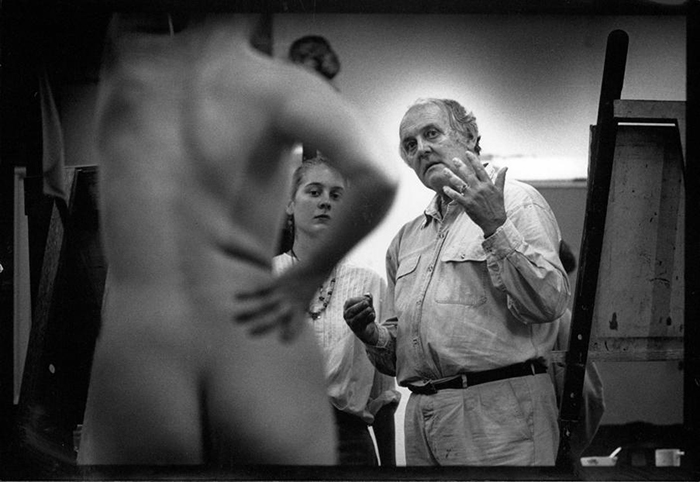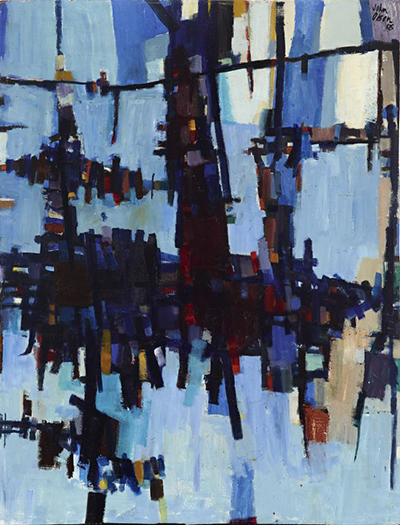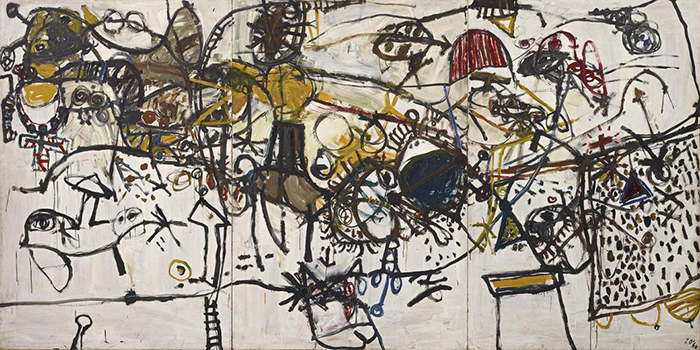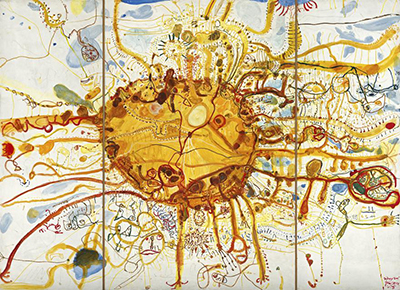
The Sun King
The Weekend Australian
10 - 11 September 2016
Ashleigh Wilson
John Olsen leans over his desk, charcoal in hand. Shadow falls over the
paper as he presses down, drawing a line from top to bottom and then
sending it curling in different directions. His hand moves with a slow,
deliberate rhythm, and he adjusts the angle of the charcoal to vary what
he calls the pace of the line. It’s a picture of a pelican, but it’s
also a demonstration of positive and negative space, male and female,
the perfect balance between the yin and the yang. “It’s the idea of the
emptiness being as full as the fullness,” he says.
Behind him stands a
large unfinished painting of Lake Eyre. It’s a work unlike anything he
has done before. This picture won’t be included in his upcoming
retrospective in Melbourne and Sydney, but he seems deeply satisfied
with its progress. With this painting, Olsen says, he is edging closer
than he ever has to Lake Eyre after wrestling with the subject for many
years. “I just had this notion of extending my experience with it.”
At
88, Olsen has a secure hold on the crown as Australia’s greatest living
painter. His work commands great respect, and he’s as close to a
household name as an artist could be. In recent years he has enjoyed a
flurry of honours, from a belated Archibald Prize in 2005 and his
elevation as life governor at the Art Gallery of NSW to two honorary
university degrees. He also added an Order of Australia to his title of
OBE.
This weekend he will travel from his home in NSW’s southern
highlands to Melbourne for the opening of a career retrospective at the
National Gallery of Victoria. The show has been put together in tandem
with the AGNSW, where it will open next year. The two galleries hosted a
retrospective of his work 25 years ago, so this exhibition is a story
of longevity, if nothing else. Certainly it’s hard to think of another
living Australian artist bestowed with two major retrospectives a
generation apart.
John Olsen's Dry Salvages (1956), named after a TS Eliot poem.
Earlier this week Olsen invited Review to his property just
outside Bowral, a 90-minute drive from Sydney and home for the past five
years. Its energy centre is his studio, a vast, light-filled space just
a few steps from his bedroom and overlooking a lake where ducks make
circles on the water. Here he sat, surrounded by paints, canvases,
brushes and books, and discussed his creative practice, his world, his
high-profile children (Tim is a prominent Sydney gallerist; Louise
co-founded Dinosaur Designs) and the passing of time.
Invited to
consider the artists no longer with him, he sighs: “Drysdale was a good
friend of mine. Nolan gone, Whiteley gone, Lloyd Rees gone. They’re
nearly all gone.”
A retrospective is an opportunity for
reflection, and Olsen is happy to oblige. There’s much to cover: the
time he protested a conservative Archibald Prize; his affection for
Spain; the heady atmosphere on his return to Australia; his Opera House
mural; his exploration of the Australian landscape; his relationship
with younger artists. He’s great company, too, charming and erudite and
witty, qualities that shine through whether he’s enjoying a long lunch
at Lucio’s restaurant in Sydney or talking about art in his studio.
But
Olsen is busy with new ideas, so there’s only so much time he can spend
looking backwards. Apart from the Lake Eyre picture, which is still
taking shape, another commission awaits his attention, a picture that
will take him back to the beginning of his own story. It’s a meditation
on Newcastle, the city of his birth.
'Where is humanity without poetry? In a terrible heap'Naturally
enough, for Olsen, that picture has its foundations in poetry. Its
title is The River is a strong brown god, a line from TS Eliot’s Dry
Salvages. As it happens, he used the title of the same poem in 1956 for a
painting in Direction 1, a show at Sydney’s Macquarie Galleries and a
breakthrough moment for the young artist. So perhaps this is a time for
both reflection and renewal, a time when the recurring patterns of the
past come into view.
“I’m finding I’m working slower at the moment.
Maybe I’m getting old.” Olsen looks up from his TS Eliot and continues
in a whisper. “I don’t feel it.”
Of all the many loves in Olsen’s life, one constant companion is
poetry. Eliot is a favourite, of course; he’s currently enjoying Peter
Ackroyd’s biography of the artist. He also loves WB Yeats, WH Auden,
Dylan Thomas, Stephen Spender and Gerard Manley Hopkins — from whom the
line “nature is never spent” seems especially apt, considering Olsen’s
tenderness towards the natural world. During our conversation, Olsen
jumps up several times to retrieve a book of poetry from the shelf to
illustrate a point. He’s also fond of quoting lines committed to memory.
One passage he has been quoting to others for some time comes from the
opening of Pied Beauty, by Hopkins:
Glory be to God for dappled things —
For skies of couple-colour as a brinded cow …
“Where
is humanity without poetry?” Olsen says. “In a terrible heap. That’s
one of the problems we have in Australia, and I guess this could be
extended to anywhere in the Western world, where poetry is very badly
taught in schools. If I was teaching poetry I could tell you that the
kids there would really, really be moved by it. But it’s passed off as
something that no one understands.”
Olsen painted Spanish Encounter (1960) in a five-hour burst on his return to Australia .
It wasn’t until Olsen travelled to Europe in the late 1950s that
he felt he really learned to harness the power of poetry. He ended up in
Majorca and fell in with the poet Robert Graves, who helped him find
focus.
“He was very good. He said that when you look at an object,
always consider its metaphorical extension. Now that was very
valuable.”
Olsen turned to poetry for one of his best-known
commissions, a work that continues to look over Sydney Harbour to the
north. It was late in 1971, two years before the opening of the Sydney
Opera House, when James Gleeson invited him to create a mural inside the
new building. Gleeson, a critic, artist and chairman of the Dobell
foundation, had been impressed by Olsen’s Spanish Encounter, a vigorous
three-panel epic that Olsen had painted in a five-hour burst on his
return to Australia a decade earlier.
Olsen decided to base the mural on Five Bells, an elegy by
Kenneth Slessor for a friend who had gone overboard in Sydney Harbour
with beer bottles in his pocket. The artist sought out Slessor, who told
him the story behind his poem, and then set to work.
“As a
young man,” Olsen says, “I was very excitable and very haptic and all
over the place. Talented, but all over the place. I just don’t feel that
anymore. I think I came close to that feeling with the Opera House.”
While
the mural will not be included in the retrospective, an earlier work,
Five Bells, will be put on display when the show travels to Sydney.
Olsen remembers the mural’s creation as a difficult period, how some of
the workers heckled him as it was coming together. But four decades on,
he thinks the picture, initially conceived as a ceramic, has aged well —
even if he’s no fan of the purple carpet in front.
Did he ever
doubt himself? “Never for a moment. Never. And we spent a lot of time
getting that purply moonlight colour, because it was important to the
theme.”
The new retrospective, jointly curated by David Hurlston and
Deborah Edwards, senior curators at the NGV and AGNSW respectively,
will present a spread of Olsen’s career, from paintings to ceramics,
tapestry, prints and drawings. Compared to the earlier retrospective, in
1991 and 1992, Olsen describes this show as a “proper summary” of his
career. There will be 108 works in total, covering six decades of work.
It
must be tempting to look back over it all and wonder what could have
been done differently. “I don’t think of perfection, because that drives
you nuts,” Olsen says. “When you’re thinking of perfection you might be
thinking of somebody else’s idea of perfection. Leonardo da Vinci’s
idea of perfection, that would have nothing to do with Rembrandt’s idea
of perfection. Perfection looks after itself.”
The title of the
show is The You Beaut Country, a reference to the series created
following his return to Australia. Olsen says the phrase draws on his
experience in Spain in the 50s — “completely isolated and very, very
poor” — and the contrast with Australia, where everything felt so
“magically alive”. It also relates to the “commitment of innocence” that
Australia had taken to Gallipoli.
“So I think that the ‘you beaut country’ has that kind of
innocence about it,” he says. “That first reaction was a reaction
against Spain’s civil war, and the contrast between coming back to
Australia. It was an extraordinary thing: it was a Saturday night. The
ship came in, there was the showboat, and there was raucous saxophone
music and the whole harbour was dancing. I didn’t have any notion of
doing the ‘you beaut country’ then, but it seemed to me to be an idea of
a contrast. A parallel to Australia’s enthusiasm.”
From this
point, Olsen travelled widely across Australia. He took in the likes of
Lake Eyre, Lake Hindmarsh, Arnhem Land and Bass Strait, and he speaks
with enthusiasm about a country that he insists is best viewed from the
air, and the great empty spaces that are anything but empty. Most
Australians, he says, cling to the edges of their country. He calls it a
“saucer-like existence”.
 John Olsen at work earlier in his career.
John Olsen at work earlier in his career.
“It’s so big and so chaotic, unlike the European landscape, which
is ordered, and honed and manicured by great poets,” he says. “The
Australian landscape is like a dog’s hind leg — and that’s the value of
Sidney Nolan. His landscapes revealed for the first time the essential
untidiness of the Australian landscape.
“But the investigation goes further. When you begin to travel over the top of it, then it begins to explain itself.”
Ben
Quilty, an admirer and a friend, a fellow Archibald-winning artist who
lives nearby in the southern highlands, identifies a life-affirming
quality that Olsen brings to all his paintings.
“The thing about
John is that he always brings it back to a very romantic, incredibly
optimistic form of visual language,” Quilty says. “Which kind of goes
against the pessimistic nature of discussion about contemporary society
and the world and politics. That’s about really the heart of what
John’s work is about. The joy of being alive.”
Olsen's Sydney sun (or King Sun) (1965).
In recent times, it feels like Olsen has been everywhere.
Darleen Bungey’s biography was published in 2014, followed the next year
by an Olsen book about the Opera House mural. Last month came the
publication of Buns in the Oven, detailing Olsen’s brief stretch running
an art school in Sydney, and next month the AGNSW will publish an Olsen
recipe book. And the twin-city retrospective will be followed by a
separate show at the Newcastle Art Gallery called The City’s Son. “It’s
very exciting,” he says, “but it’s very exhausting too.”
There is
good cause for Olsen to be distracted: his wife of 27 years, Katharine,
has just received treatment for a brain cancer. Olsen says the renowned
neurosurgeon Charles Teo led the operation, and she is now recovering
back at home. “She’s doing well.”
As soon as he returns from
Melbourne, Olsen will start work on his Newcastle commission. He has
plenty of ideas: there’s a notebook filled with sketches of the city and
its industrial complexion, as well as Eliot’s words about the strong,
brown river god, sullen, untamed and intractable. “I’ve got an affection
for Newcastle,” he says, “a great affection.”
Does he fear running out of ideas? Olsen points to the Lake Eyre
painting in progress against the wall: rivers snake to the sea, a blue
expanse framed by the legs of Mother Earth, all rushing together with
that inimitable Olsen sense of line and colour.
“Just look at
that. That’s entirely different to any interpretation I’ve done of Lake
Eyre. And it’s reinforced by a better philosophical attitude.”
The
artist leans back in his chair. A moment passes, and the conversation
turns to the Greek poet Constantine Cavafy, whose poem Ithaka encourages
attention on the journey rather than the destination.
“It’s the travelling through,
you see,” he says. “There’s a way of painting — Jeffrey Smart did it
this way — in which you do a very detailed small work and you scale it
up and transfer it on to a canvas.
“To my mind, I only have a
theme and I concentrate on where I am, whether it’s Lake Eyre or Sydney
Harbour. I’m travelling, but I don’t know where I’m going to finish.”
John Olsen: The You Beaut Country
is at the National Gallery of Victoria from September 16 to February
12; then at the Art Gallery of NSW from March 10 to June 12.
John Olsen: The City’s Son is at the Newcastle Art Gallery from November 5 to February 19.
Read full article here - http://www.theaustralian.com.au/arts/review/john-olsen-retrospective-at-ngv-reveals-poetry-in-his-palette/news-story/962ae0a947cfab0ebc1723795a5d6ebc
_back to previous page



 John Olsen at work earlier in his career.
John Olsen at work earlier in his career. 